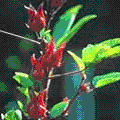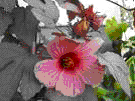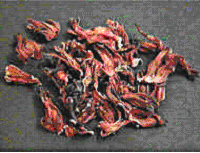Hibiscus
| |
Egyptology Articles
Herbs and Aroma
Alternative
Medicine
Aroma Therapy
|
|
Hibiscus plant is one of the most famous plants
of the enchanting city of Aswan.
Aswan is in Upper Egypt and is also famous for
its marvelous sight-seeing tours and monuments. The botanical name
of this plant is Hibiscus Sabdariffa.
Its common name is
Roselle. Hibiscus plant has many
varieties and is planted world-wide.
There are over 100 cultivars or
seed varieties of Hibiscus sabdariffa. The major
commercial varieties are those grown in China, Thailand, Mexico and
Africa, principally Sudan, Senegal and Mali and Egypt.
Its Arabic name is Karkade,
which is exactly like the German name. It has many medicinal uses, together with
the most appealing flavor as an herbal tea.
Hibiscus is a lovely annual
flower with beautiful red flowers, commonly grown in flower gardens or indoor
pots.
The flowers are not just for
scenic pleasure, but have amazing flavoring qualities. In Africa, Karkade is the
name given to a delicious hibiscus punch. It is also a great contribution to the
popular rosehip tea giving it a lemony flavor and lovely red color.
|
 |
| |
Hibiscus |
|

|
|
Hibiscus Flower |
Hibiscus sabdariffa is a member of the
Malvaceae family. It is an annual herb that grows to 6 feet or more, stems are
glabrous; lower leaves are ovate with the upper leaves being 3-5 palmately
lobed. The flowers are axillary or in terminal racemes, the petals are white (or
pink) with a reddish center at the base of the staminal column, the calyx
enlargens at maturity and the fruit is fleshy and bright red. Its flowers are
also light yellow, sometimes with pink, and a dark red eye, and they open, after
growing through long, hot summers, when the days become shorter. The calyx
becomes fleshy and enlarged creating a bright red, acid fruit of 1 ¼ inches.
Hibiscus sabdariffa is very sensitive to changes in the length of day..
Sometimes,
Roselle and an entirely different species, Hibiscus acetosella (Red
Leaf Hibiscus, False Roselle, etc.), are mistaken for each other. Propagation is
through its light brown, kidney-shaped seeds in the spring.
|

|
|
Most of the
plant is used for different things. |
The calyces are used to make
cold and hot beverages in many of the world's tropical and subtropical
countries. In China the seeds are used for their oil and the plant is used for
medicinal properties.
The aroma and taste of
Hibiscus is slightly of berry-like aroma. It has a well balanced, tart and
astringent flavor.
Medicinally, leaves are
emollient, and are much used in Guinea as a diuretic, refrigerant, and sedative;
fruits are antiscorbutic; leaves, seeds, and ripe calyces are diuretic and
antiscorbutic; and the succulent calyx, boiled in water, is used as a drink in
bilious attacks; the leaves and powdered seeds are eaten in West Africa. Philippines use the bitter root
as an aperitive and tonic. Angolans use the mucilaginous leaves as an emollient
and as a soothing cough remedy.
Hibiscus flower extract has been used in many folk remedies for
liver disorders and high blood pressure.
The constituents of the
flowers contain gossypetin, anthocyanin, and glucoside hibiscin, which may have
diuretic and choleretic effects, decreasing the viscosity of the blood, reducing
blood pressure and stimulating intestinal peristalsis. Karkade (dried-flowers
minus-ovary) contains 13% of a mixture of citric and malic acid, two
anthocyanins gossipetin (hydroxyflavone) and hibiscin, and 0.004–0.005% ascorbic
acid. Petals yield the flavonal glucoside hibiscritin, which yields a
crystalline aglycone—hibiscetin .Flowers contain phytosterols.
The dried flower contains
hibiscic acid .Root contains saponins and tartaric acid. Aspartic acid is the
most common amino acid. Dried fruits also contain vitamin C and Ca oxalate; dry
petals contain flavonol glucoside hibiscitrin.
It
is thought that the antioxidant chemicals, such as flavonoids, polyphenolics and
anthocyanins, contained in the flower play a large role in preventing the
oxidation of low density lipoproteins (the “bad cholesterol”). This oxidation is
what contributes to atherosclerosis, the build up of a waxy plaque on the walls
of arteries.
Uses
Hibiscus has many medicinal
uses, of which some are still under research as researchers are learning
everyday more and more of its use.
It also serves as a very
delicious beverage which is refreshing and beneficial.
The medicinal uses of
Hibiscus were known from a long time ago. It has a major diuretic effect. Many
Egyptian now use it to lower their blood pressure, an idea maybe taken from folk
medicine.
It act as an antiseptic,
aphrodisiac, astringent, cholagogue, demulcent, digestive, diuretic, emollient,
purgative, refrigerant, resolvent, sedative, stomachic, and tonic.
Roselle is a folk remedy
for abscesses, bilious conditions, cancer, cough, debility, dyspepsia, dysuria,
fever, hangover, heart ailments, hypertension, neurosis, scurvy, and strangury.
Researchers now are doing
studies to see if Hibiscus is indeed active in lowering blood cholesterol
levels. This could be due to the high antioxidant
content contained in the hibiscus extract that contributes to lowering low
density lipoprotein levels in the blood.
|

|
|
Hibiscus Flower |
Culinary uses
Roselle's fruity flesh and
cranberry-tasting juice produce a variety of different foods, including health
foods, sauces, jellies, iced drinks, and herb teas.
Hibiscus is a source of a
red beverage known as Karkade (jamaica in Mexico), which is said to contain
citric acid and salts, serving as a diuretic.
Karkade is used in jams,
jellies, sauces, syrup, gelatin, refreshing beverages, pudding, and cakes, and
dried roselle is used for tea, jelly, marmalade, ices, ice-cream, sherbets,
butter, pies, sauces, tarts, and other desserts.
Tender leaves and stalks are
eaten as salad and as a pot-herb and are used for seasoning curries. Seeds have
been used as an aphrodisiac coffee substitute. Fruits are edible.
Roselle is cultivated
primarily for the bast fiber obtained from the stems. The fiber strands, up to
1.5 m long, are used for cordage.
Hibiscus is also used in
soap making and bath tea bags.
 |
 |
|
hibiscus
calyceas. |
dried hibiscus flower |
|
You may freely reprint this article
or place it on your website by
adding this statement: Courtesy of www.kingtutshop.com
|
_________________________________





